GENETICS: Resveratol; The Gene Inducer, DNA, Genes and Chromosomes
You are probably inundated with information about how bad drinking alcohol can be, but one group of scientists are convinced that taking large quantities of one of the compounds found in red wine could be the answer to a long and healthy live. Red wine and the red grapes that are used to make it contain a molecule called resveratrol. Studies have shown that mice given resveratrol and a high-fat diet didn’t gain weight and lived longer than those just fed the stodge. This might explain why the French enjoy a high-fat diet yet suffer less heart disease than Americans.

Resveratrol is a gene inducer that turns on expression of a gene called SIRT-1 in mice, and possibly also in humans. This gene is highly expressed in animals and humans fed a low-calorie diet and it does seem to be linked with living longer. One scientist, David Sinclair of Harvard University in the USA, is convinced that taking high amounts of resveratrol, equivalent to drinking about 15 glasses of red wine a day, could prevent human ageing and extend lifespan. He has founded a pharmaceutical company to investigate this further. However, approval cannot be given for a drug that just prevents ageing as the US Food and Drug Administration, the body that approves drugs, does not recognize ageing as a ‘disease’. Resveratrol may have other beneficial effects though and the company has begun clinical trials to see if an improved version of resveratrol can help control glucose levels in people with diabetes.
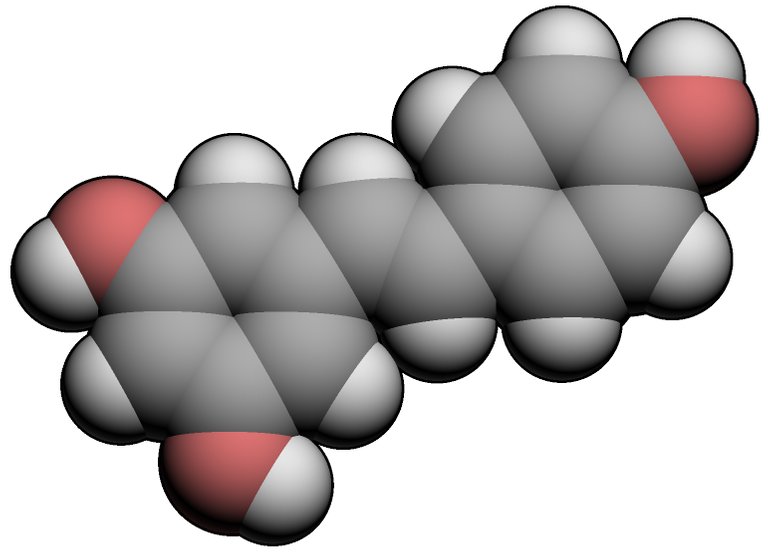
Chemical structure of trans-resveratrol. Ccroberts, Public Domain
WHAT IS A GENE?
The nucleus of a eukaryotic cell has a set number of chromosomes – every human body cell has 46. Each chromosome is a single, elaborately coiled DNA molecule that has individual genes dotted along its length. A gene is a length of DNA that codes for the synthesis of one polypeptide. We used to think that a gene contained all the information needed to build a complete protein, such as an enzyme. However, many proteins consist of more than one polypeptide chain, so these molecules are coded for by more than one gene. For instance, haemoglobin molecules consist of four polypeptide chains, two alpha and two beta, so it takes two genes to make a complete haemoglobin molecule – one is copied twice for the alpha chains and the other twice for the beta chains. The position of a gene on a chromosome is known as its locus (plural: loci).
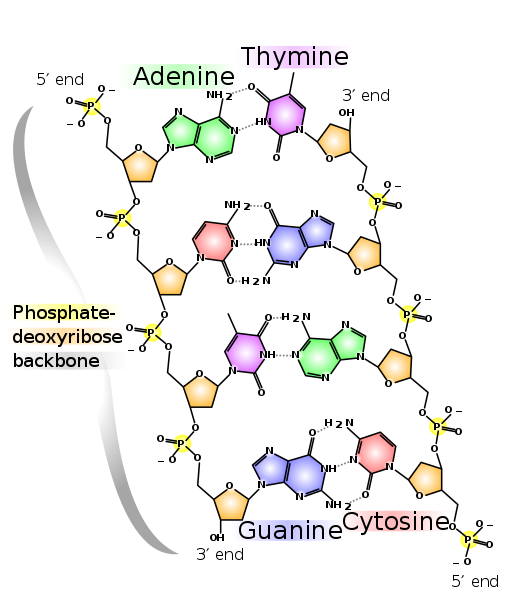
GENES IN ACTION: The Central Concept Of Molecular Biology
Can we sum up the way genes work in one sentence? It is a tall order, but the underlying theme, or central dogma, of genetics is: The DNA of a gene codes for the production of messenger RNA, which, in turn, codes for the production of a polypeptide. Retroviruses such as the Human Immunodeficiency Virus (HIV) are an exception to the central dogma. Retroviruses contain RNA from which they make a DNA copy using the enzyme reverse transcriptase.
In this chapter, we look at how genes work, and at how they are copied to allow cell division, reproduction and growth.
After Crick and Watson worked out the structure of DNA in 1953, two vital questions remained:
- How does information get from the DNA in the nucleus to the site of protein synthesis in the cytoplasm?
- How does the base sequence of the DNA translate into the amino acid sequence in a polypeptide?
To answer the first question, Crick, Brener and Monod developed the messenger hypothesis. This states that a specific molecule, named messenger RNA (mRNA), is copied directly from the DNA sequence of the gene. mRNA is therefore a mobile copy of a gene. It can move from the nucleus to the cytoplasm. Here, ribosomes use mRNA as a template (pattern) to assemble amino acids in the correct order to make the required polypeptide.
Crick also answered the second question: he proposed that an ‘adaptor’ molecule exists which has two specific binding sites. At one side, the molecule fitted a specific DNA base sequence and at the other, a specific amino acid. This molecule was later discovered and named transfer RNA (tRNA).
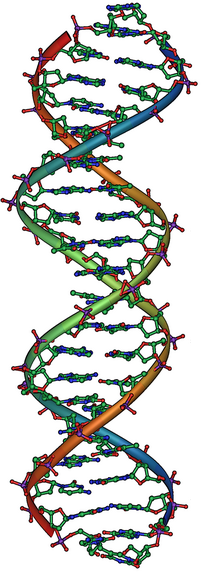
THE GENETIC CODE
Along the DNA molecule the base sequence is continuous, but it is read in blocks of three. Each three, or triplet, is called a codon. Each codon codes for a particular amino acid. A particular sequence of bases therefore codes for a specific amino acid sequence. When the amino acids are assembled into a polypeptide, they interact to twist and bend the chain into its final shape. When the polypeptide chain is complete, it forms all or part of a protein which performs a vital role in the organism.
You will have noticed that there are two strands of bases in the DNA molecule. One strand, called the template strand or sense strand, contains the all-important genetic code for any particular gene. The corresponding part of the other strand is simply there to stabilize the molecule. However, in the same DNA molecule, different genes are present in different sides, and the enzymes that transcribe DNA can use either side as the sense strand.
The genome is defined as ‘all the DNA sequences in an organism’. It is a complete set of genes, together with the non-coding DNA in between. The human genome is thought to consist of over 3 billion base pairs. Remarkably, the entire genome is present in every one of our body cells.
The base pairings are always the same. In DNA, A bonds with T and G with C. In RNA, T is replaced by U, so A bonds with U and G with C.
Nucleic acids-molecules with jobs
A favourite topic for biology examiners is to ask the candidate to relate structure to function. On a molecular level, the nucleic acids are classic examples. This feature builds on your knowledge of the basic structure of nucleic acids. The differences between DNA and RNA are shown in the table below.
The differences between DNA and RNA
| DNA | mRNA | tRNA | |
| Sugar | deoxyribose | ribose | ribose |
| Bases | C, G, A, T | C, G, A, U | C, G, A, U |
| Strands | two | one | one |
| Size of molecule | enormous | mall compared with DNA, varies with size of gene | small, constant size |
| Life span | long-term | short-term | short-term |
| Site of action | nucleus | nucleus and cytoplasm | cytoplasm |
DNA
How is the structure of DNA related to its function?
- It contains a sequence of bases that codes for a sequence of amino acids. Cells use this genetic code to make the proteins that build organisms. The base sequence is read in blocks of three, e.g. GAU – this is a codon.
- It is long, so can store a lot of information.
- It has complementary base pairing that allows replication and transcription.
- It has a stable sugar-phosphate backbone to give strength.
- It has relatively weak hydrogen bonds between the bases. This allows the two strands to come apart – again allowing replication and transcription.
Messenger RNA
mRNA is simply a mobile copy of a gene, carrying a base sequence that is complementary to – not the same as – the gene on which it was made. mRNA molecules are long, ribbon-like molecules consisting of a single strand of nucleotides. Molecules of mRNA vary in length – there are as many different ones as there are genes.
Transfer RNA
This is the adaptor molecule, connecting the genetic code to the protein, tRNA molecules have an anticodon on one end and an amino acid binding site at the other. The role of tRNA is to pick up a particular amino acid, bring it to the ribosome and hold it in place so it can be added to the growing polypeptide, tRNA binds to the mRNA by means of the anticodon. It could be argued that because there are 20 different amino acids, there are 20 different types of tRNA molecule. Another way of looking at it is that there are 61 different codons (64 minus 3 stop codons), so there are 61 different types of tRNA.
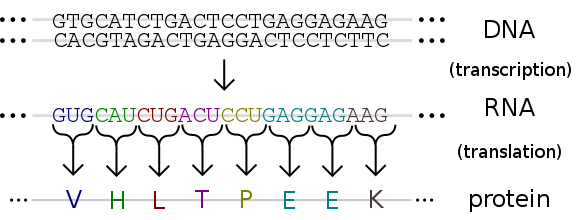
TRANSCRIPTION
DNA can be thought of as a permanent reference library: it does not leave the nucleus and so cannot be used directly for protein synthesis. Instead, the genetic code in a gene is transferred, or transcribed, on to a smaller RNA molecule, messenger RNA, which can then pass to the ribosomes to act as a template for protein synthesis. In effect, mRNA is a mobile copy of a gene.
Before transcription can begin, the DNA helix must unwind and the two halves of the molecule must come apart, so exposing the base sequence. This process begins when the DNA is ‘unzipped’ by specific enzymes and the enzyme RNA polymerase attaches to the DNA molecule at the initiation site. This is a base sequence at one end of the gene which effectively says: start here. Once in place, the enzyme moves along the gene, assembling the messenger RNA molecule by adding the matching nucleotides, one at a time. Once formed. The mRNA copy begins to peel away from the DNA. When RNA polymerase has passed a particular region of DNA, the double helix rewinds. When the whole gene has been transcribed, the complete mRNA molecule leaves the nucleus. As on a production line, RNA polymerase molecules can follow each other along the gene, assembling several copies of mRNA together.
TRANSLATION
Translation occurs when the base sequence on the mRNA is used to synthesize a polypeptide. The process is called translation because the information contained in the gene – and delivered by the mRNA is translated into a polypeptide. Protein synthesis is one of the major activities of cells, and it is highly likely that you are already familiar with many of the organelles and chemicals involved.
Translation occurs on ribosomes, structures that hold all the components together as an amino acid chain is made. The mRNA strand passes out of the nucleus and attaches to the ribosome. At the point of attachment, two tRNA molecules deliver the required amino acids and hold them in position se that they can be added to the growing polypeptide. The process continues until an mRNA stop codon – which has no tRNA molecule moves into the ribosome’s first binding site. At this point, all the components separate, releasing the completed połypeptide.
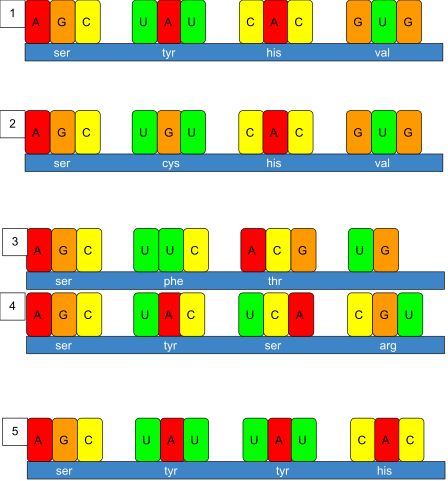
After translation, polypeptides are processed according to their final destination:
- Those that are to be exported from the cell. Such as digestive enzymes are threaded through pores in the endoplasmic reticulum to accumulate on the inside. Here they are processed and packaged before being secreted.
- Polypeptides that will form membrane proteins follow the same route as those for export, but they remain on the cell surface membrane rather than being released.
- Polypeptides that will be used inside the cell, such as those that form haemoglobin, remain free in the cytoplasm.
In my next post, I’ll discuss the role of transfer RNA, polysomes, rate of translation and the journey along a chromosome.
Thanks for coming.
REFERENCES
https://www.msdmanuals.com/home/fundamentals/genetics/genes-and-chromosomes
https://www2.le.ac.uk/projects/vgec/highereducation/topics/dna-genes-chromosomes
https://www.mayoclinic.org/diseases-conditions/heart-disease/in-depth/red-wine/art-20048281
https://en.wikipedia.org/wiki/Resveratrol
https://www.drugs.com/resveratrol.html
https://www.webmd.com/heart-disease/resveratrol-supplements
https://en.wikipedia.org/wiki/Gene
https://ghr.nlm.nih.gov/primer/basics/gene
https://www.yourgenome.org/facts/what-is-the-central-dogma
https://en.wikipedia.org/wiki/Central_dogma_of_molecular_biology
https://courses.lumenlearning.com/boundless-biology/chapter/the-genetic-code/
http://www.genomenewsnetwork.org/resources/timeline/1960_mRNA.php
https://www.sciencedirect.com/science/article/pii/S0960982215006065
https://www.sciencedaily.com/terms/genetic_code.htm
https://www.britannica.com/science/genetic-code
https://en.wikipedia.org/wiki/Genetic_code
This post has been voted on by the SteemSTEM curation team and voting trail. It is elligible for support from @curie and @minnowbooster.
If you appreciate the work we are doing, then consider supporting our witness @stem.witness. Additional witness support to the curie witness would be appreciated as well.
For additional information please join us on the SteemSTEM discord and to get to know the rest of the community!
Thanks for having used the steemstem.io app and included @steemstem in the list of beneficiaries of this post. This granted you a stronger support from SteemSTEM.
I know you are highlighting resveratrol, but it is linked in the study to reduced caloric intake. What role is it suggested that reduced calories plays in increased lifespan?
Some months ago @scienceblocks wrote a post The quest for elixir of life - understanding caloric restriction (episode 1 - DNA damage and repair), and others have also written about caloric restriction. This seems to be a trend. However, when I look up studies that correlate body mass to mortality, reduced body mass does not seem to insure greater longevity. Here are two studies I just looked up:
https://www.ncbi.nlm.nih.gov/pmc/articles/PMC5499607/
https://www.ncbi.nlm.nih.gov/pubmed/24561114
How to reconcile these studies with data that shows caloric restriction increases lifespan?
I guess I resist the caloric restriction theory because I don't like to be hungry :)
That's a really comprehensive discussion of genes, RNA and DNA! Thank you,
Great article, but I have a comment about something that I saw on Reddit regarding this post.
Yes, resveratrol is in red wine, but not in the high concentrations that would be needed to serve as an alternative to the mice studies cited.
The amount of red wine needed would lead to severe fatty liver disease that isn’t witnessed in the French population.
There are other factors that better explain the lower heart disease in France vs USA. I’m here may include lower overall calories, less refined sugars drank, more active lifestyle, etc.